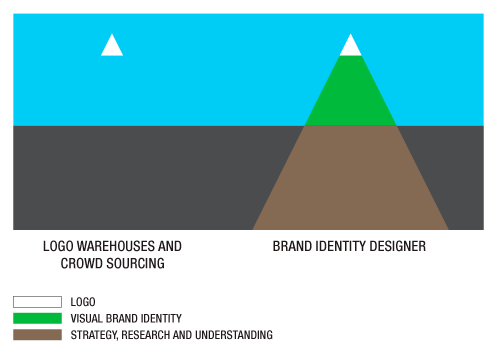
Logo design should not be approached with the goal of filling that blank spot on the top of your letterhead. It is not the time to recklessly do something trendy and cool. Most importantly, it is not about getting a task off your to-do list so you can move on to selling widgets to your customers.
The logo design process should provide value far beyond the delivery of a symbol.
Design is not a product
Many logos however are being sold simply as a graphic. Crowdsourcing and online logo warehouses make the purchase quick and easy with little need for any true understanding. Both the client and “designer” are released from investing in developing a deep understanding of brand, strategy, marketing and design principles.
By removing the requirement of understanding, logos can be sold as if they themselves are widgets with plug-and-play compatibility — a generic product that can be applied to whoever wants it.

Understanding is a service
Logo design should always be considered as part of a larger brand strategy. It is an opportunity to develop cohesive and consistent messaging tailored to a specific set of customers. To accomplish this requires customization, knowledge and skill. It demands that design is viewed as a service and not a product. It requires strategy.
Without a complete and well thought out strategy, you can’t successfully influence where a company is heading. A bank won’t hand money to a company that operates without a strategy, and, over time, neither will customers. They will choose to buy from a company with a solid strategy, a consistent message, and a defined direction — one with a strong brand.
While a graphic designer can help with the nurturing, a logo alone is not the solution to developing a strong brand. This strength can only come from understanding. The company must understand their business, competition, market space, preferences, trends, strengths, weaknesses, and most importantly why customers should care about them.
Understanding goes the other way, too. If their customers can’t understand what it is that makes the company unique and why they should care, then they cannot develop a connection. No connection, no strength.
One of the greatest values a graphic designer can provide is the ability to successfully translate this understanding into a visual brand.
Understanding is the missing link
Online logo warehouses and crowdsourcing put the onus on the client to ask the right questions, to validate the answers, and to translate that information into the selection of a graphic. In doing so, they remove the most critical part of any identity project — the focus on developing an understanding.
A graphic designer must provide a bridge of understanding between a company and its audience. They must ask the right questions, pushing the client for authenticity. They must then validate the responses, making sure there are no gaps in understanding or differences in thinking. They must provide direction and guidance built on strategy.
Logo sweatshops and crowdsourcing websites pretend this “little detail” has no value. They thrive on clients believing a logo is only meant to fill an empty space.
So I need understanding and not a logo?
No. You need an identity built on understanding, and the cornerstone for that is a logo. At the end of the logo design process you want:
1. A Creative Brief. A document derived from answers to hard questions. Developing the creative brief is vital to solidifying direction, objectives, audience and tone. In almost all cases, this is not an easy document to create.
2. A Partner. The designer should become part of your team. They should be available to provide support and advice throughout the project and into the future. As a partner, they must remain aware of your evolving brand and how best to leverage it.
3. A Logo. The obvious deliverable, the logo is part of a larger branding strategy and must meet all technical and creative requirements for the foreseeable future.
4. A Roadmap. You need to be armed with a strong sense of where the visual brand is heading and how it integrates with your marketing plans. At a minimum, this may be in the form of guidelines for the use of color, fonts and the logo itself, but often involves mock-ups of the brand in action.
But it costs more
Yes, but you receive better value. Hiring a graphic designer ensures there is a solid foundation for your visual brand built on understanding. This is certainly worth more than a graphic that looks cool but leaves you floating with a hollow and unauthentic reflection of your brand.
The most loved brands, the ones that last, are authentic. They are not a cheap veneer that peels away over time. Authenticity requires understanding. Understanding requires experience. Experience requires time. Time costs money.
Logo design and branding are not about getting an item off your to-do list. It is an ongoing exercise in fostering understanding and there is no $99 solution for that.

No hay comentarios:
Publicar un comentario